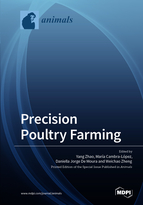Precision Poultry Farming
A special issue of Animals (ISSN 2076-2615). This special issue belongs to the section "Animal System and Management".
Deadline for manuscript submissions: closed (31 December 2021) | Viewed by 44138
Special Issue Editors
Interests: animal smart sensoring; robotics; behavior monitoring; welfare assessment; airborne transmission of pathogens; and environment management
Special Issues, Collections and Topics in MDPI journals
Interests: animal production; feeding animals; animal nutrition; environment; precision poultry farming
Special Issues, Collections and Topics in MDPI journals
Interests: precision livestock farming; animal welfare; smart housing
Special Issues, Collections and Topics in MDPI journals
Special Issue Information
The increase of global population comes along with growing demands on protein resources. To meet such demands, world poultry meat and egg production soared in the past few decades and is projected to keep growing in decades to come. While the poultry production makes crucial contributions to food and nutrition security, it uses substantial natural and human resources and has significant impacts on society, economy, public health, and environment. Although the extent of these impacts may vary among continents and countries due to differences in production practices and social structures and preferences, the world poultry industry, as a whole, should strive to keep improving sustainability and efficiency in the resource usage. Precision Poultry Farming (PPF) features applications of continuous, objective, and automated sensing technologies and computer tools for sustainable and efficient poultry production; and it offers solutions to poultry industry to address challenges in terms of poultry management, environment, nutrition, automation and robotics, health, welfare assessment, behavior monitoring, waste management, etc.
We invite original research papers, on a global scale, that address sustainability and efficiency of poultry industry and explore above mentioned areas through applications of PPF solutions in poultry meat and egg production for this special issue of “Precision Poultry Farming”.
Dr. Yang Zhao
Dr. María Cambra-López
Dr. Daniella Jorge de Moura
Dr. Weichao Zheng
Guest Editors
Manuscript Submission Information
Manuscripts should be submitted online at www.mdpi.com by registering and logging in to this website. Once you are registered, click here to go to the submission form. Manuscripts can be submitted until the deadline. All submissions that pass pre-check are peer-reviewed. Accepted papers will be published continuously in the journal (as soon as accepted) and will be listed together on the special issue website. Research articles, review articles as well as short communications are invited. For planned papers, a title and short abstract (about 100 words) can be sent to the Editorial Office for announcement on this website.
Submitted manuscripts should not have been published previously, nor be under consideration for publication elsewhere (except conference proceedings papers). All manuscripts are thoroughly refereed through a single-blind peer-review process. A guide for authors and other relevant information for submission of manuscripts is available on the Instructions for Authors page. Animals is an international peer-reviewed open access semimonthly journal published by MDPI.
Please visit the Instructions for Authors page before submitting a manuscript. The Article Processing Charge (APC) for publication in this open access journal is 2400 CHF (Swiss Francs). Submitted papers should be well formatted and use good English. Authors may use MDPI's English editing service prior to publication or during author revisions.
Keywords
- Precision Poultry Farming
- Precision Livestock Farming
- Precision nutrition
- Poultry environment
- Poultry production system
- Poultry robotics
- Poultry health
- Poultry welfare and behavior
- Poultry biosecurity
- Sensors
- IoT
- Machine learning and deep learning
- Deep learning
- Big data
- Computational fluid dynamics (CFD)









